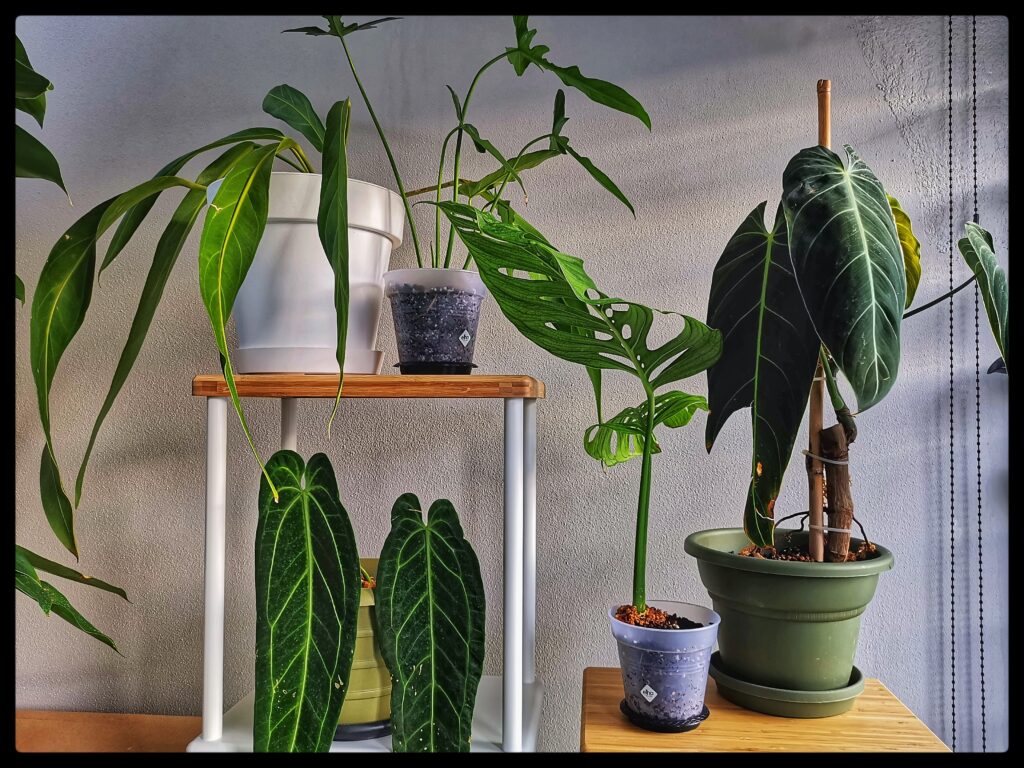Up till 18 months ago, perhaps even a little further back, I’ve never had much of a thing for those green little things from the plantae family. Not many of them have survived under my leadership. My grubby little fingers were as brown as the soil and dust that these things eventually became under my care (make no mistake, cactuses and succulents still do die under my watch). Yet, beggaring belief, I’ve cultivated (all pun intended) a certain degree of affinity, almost bordering on compulsion, towards a small, select group of plants – aroids.
Within the aroid family, there are a few genuses that I am particularly partial towards, largely because they play to my obsessive tendencies of “collecting” aka “the hunt” for being rare and exotic (but not to the level that these are endangered under CITES definition). These are philodendrons, anthuriums, monsteras and alocasias. Most of these species are endemic to South America, but I have acquired a few of them through a contact in Bogor, Indonesia.
Philodendrons and anthuriums in turn have mostly formed the majority of my budding collection, for reasons that I have only recently been able to articulate (to which I find unashamedly but unsettlingly shallow) – they have nice, large, exotic looking leaves (upon reaching adulthood, leaves span 4-5 feet). (Alocasias have thinner leaves, making them a favorite fodder for spider mites). Thanks to my OCD and the limitless reach of the internet, I’ve amassed around 20+ plants from just those 2 genuses (see Footnote A below for an exhaustive list), over the last 10 weeks – fast and furious.


Digging deeper into the recesses of the chaos that is my past, there is another recurring theme to these seemingly random hobbies that I am susceptible to – the ability to tinker, and incorporate technology. What cannot be changed, must be borne. For these collection of plants, I’ve found reasons to acquir a UV/IR grow light, Bluetooth/WiFi temperature and humidity monitor/loggers, smart plugs to control fans (circulation), a camera to monitor these plants during the day (when I am out of the house), and as of an hour ago, a portable air cooler to directly intervene in the temperature and humidity control – all with the goal of tweaking seemingly endless combinatorics of hyperparameters of plant growth. Like photography, where a tripartite relationship exists between shutter speed, aperture and ISO, keeping plants alive is an inextricably fine balance between the potting mixture, the watering schedule and sunlight. [This is another manifestation of the anxiety I suffer because my mind cannot stay at rest. I constantly need to think and my hands to move. It has been my unwavering mantra, fettle and challenge throughout life.]
While the watering cycles can be seemingly repetitive and endless, keeping to a methodical approach that involves a balance between science (e.g. potting mixture, see Footnote B + what goes into the water, mostly foliar feeds and this wonderful thing from Japan called HB-101) and art (e.g. observing the leaves, potting mixture, weather over the past 3-4 days) makes life a little bit more manageable and sustainable. And at the end of the day, when all is said and done – the cathartic moments are the rewards, they follow from seeing, on a daily basis, the thriving jungle.
It lasts for all of 3.5 days. Then I get off the chair to lather, rinse and repeat.
Footnote A:
1. Philodendron giganteum variegated
2. Anthurium willdenowii
3. Philodendron spectabile
4. Philodendron davidsonii
5. Philodendron warscewiczii
6. Anthurium polydactylum
7. Philodendron melanochrysum
8. Philodendron longilobatum
9. Anthurium papililaminum
10. Monstera epipremnoides
11. Anthurium warocqueanum
12. Anthurium pseudospectabile
13. Anthurium veitchii
14. Philodendron holtonianum
15. Anthurium bakeri
16. Anthurium vittarifolium
17. Melanochrysum x verrucosum
18. Philodendron xanadu
19. Monstera deliciosa
20. Ficus everest
21. Alocasia Wentii
22. Alocasia zebrina
23. Philodendron micans
24. Thaumatophyllum spruceanum
Footnote B:
My potting mixture attempts to replicate the almost soil-less environment that these epiphytic (tree-climbing) aroids find themselves in the forest. Roughly:
40% Akadama (bonsai soil)
20% orchid potting mix (I’ve done without this as well, with no issues)
10% charcoal
10% perlite
10% pumice
10% leca
This mixture, on balance, makes for a porous mixture that requires watering only twice weekly. I mist the plants daily, and as of tomorrow, will attempt to bring the temperature down 3-4 degrees at night while keeping the relative humidity at 70-80%.